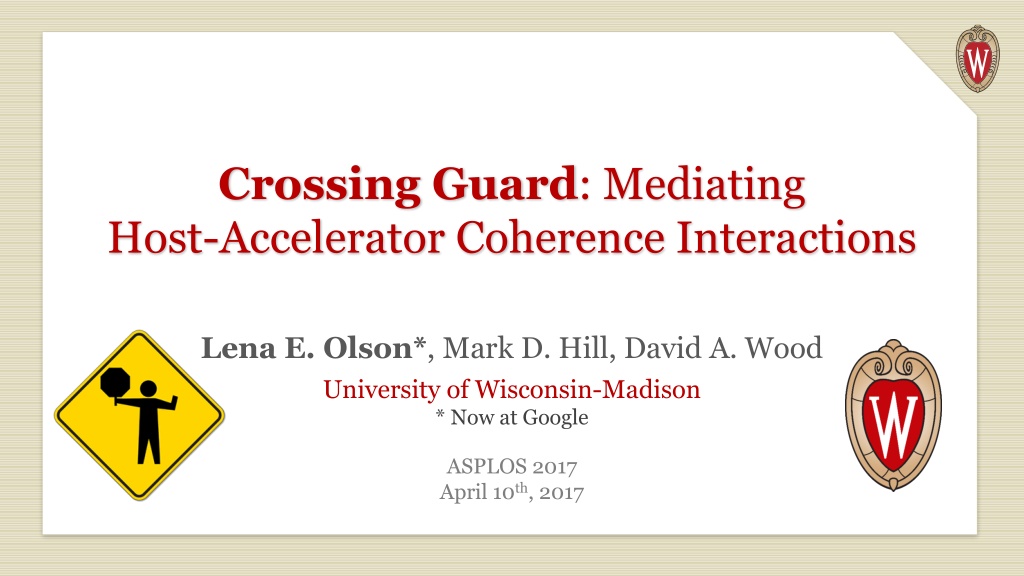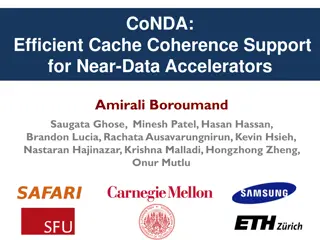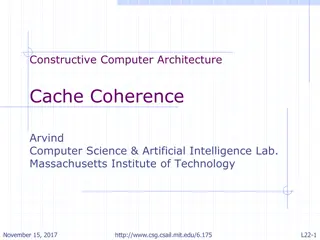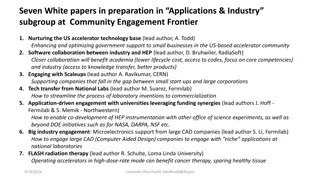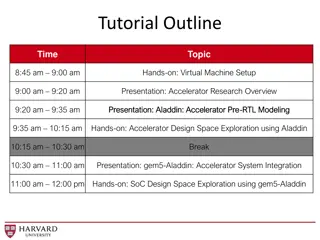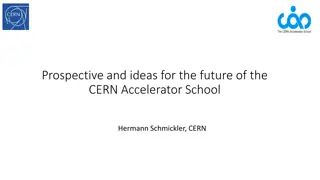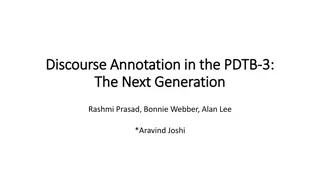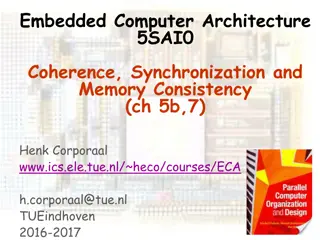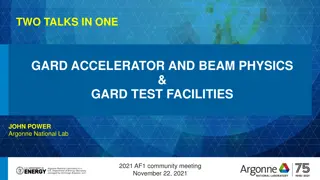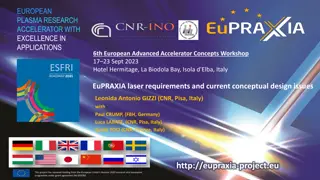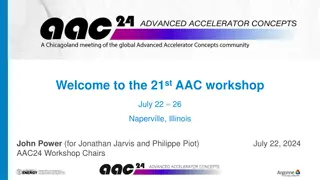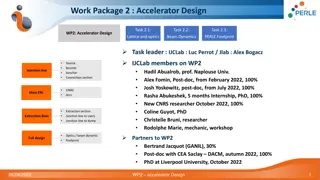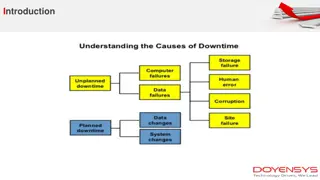Enhancing Accelerator-Host Coherence with Crossing Guard
Explore the need for coherence interfaces in integrating accelerators with host protocols, addressing complexities and safety concerns, emphasizing customizable caches and standardized interfaces for optimal performance and system reliability.
Download Presentation

Please find below an Image/Link to download the presentation.
The content on the website is provided AS IS for your information and personal use only. It may not be sold, licensed, or shared on other websites without obtaining consent from the author. Download presentation by click this link. If you encounter any issues during the download, it is possible that the publisher has removed the file from their server.
E N D
Presentation Transcript
Crossing Guard: Mediating Host-Accelerator Coherence Interactions Lena E. Olson*, Mark D. Hill, David A. Wood University of Wisconsin-Madison * Now at Google ASPLOS 2017 April 10th, 2017
Accelerators are here! Complex, programmable accelerators increasingly prevalent Many applications: graphics, scientific computing, video encoding, machine learning, etc Accelerators may benefit from cache coherent shared memory May be designed by third parties 2
However Host coherence protocols may be proprietary and complex Bugs in accelerator implementations might crash host system! Crossing Guard: coherence interface to safely translate accelerator host protocol Accel CPU Accel $ Host $ XG 3
Outline Goals Design Guarantees Evaluation 4
Crossing Guard Goals When adding accelerators to host coherence protocol: 1. Allow accelerators customized caches 2. Simple, standardized accelerator coherence interface 3. Guarantee safety for the host system 5
1. Why Customize Caches? CPU caches have to work with most types of workloads Accelerators may only run some workloads! Optimize caches for likely data access patterns Number of levels, writeback vs. writethrough, MSI vs VI, etc. Accel Accel Accel Accel Accel Accel L1 $ L1 $ VI L1 $ VI L1 $ L1 $ L1 $ L2 $ L2 $ 6
2. Why Simple, Standardized Interface? Host systems speak different protocols Accel L1 $ Expensive to redesign for each one! Intel, AMD, ARM, IBM, Oracle CCIX shows industry cares! Host Directory 7
2. Why Simple, Standardized Interface? L1 controller from gem5 s MOESI_hammer Events States (Transition table in style of Sorin et al.) 8
3. Why Host Safety? Accel Cache (#0) CPU Accel CPU Cache #2 Cache #1 Addr State A Addr State A Addr State A I I S Addr State Owner/Sharers Req A SS Directory 1, 2 - 9
3. Why Host Safety? Accel Cache (#0) Cache #2 Cache #1 Addr State A Addr State A Addr State A I I S Ack Addr State Owner/Sharers Req A SS Directory 1, 2 - 10
3. Why Host Safety? Accel Cache (#0) Cache #2 Cache #1 Addr State A M Addr State A Addr State A I I Inv Req: dir Addr State Owner/Sharers Req A MT A MT_I Addr State Owner/Sharers Req Directory 0 0 - - 11
Outline Goals Design Guarantees Evaluation 12
Crossing Guard Hardware translating between host and accelerator protocols Accel CPU Accel $ Host $ XG Set of accelerator host coherence messages (like an API) 13
Crossing Guard Interface Accelerator Host Requests Host Accelerator Responses GetS, GetM DataS, DataE, DataM PutS, PutE, PutM Writeback Ack Host Accelerator Requests Invalidate Accelerator Host Responses InvAck, Clean Writeback, Dirty Writeback 14
Crossing Guard Hides implementation details of host protocol No counting acks, sending unblocks, handling races, etc. Moves protocol complexity into Crossing Guard hardware Only implemented once per host system By experts! 15
Experimental Implementation Coherence controllers / protocols implemented in slicc Simulations using gem5 Code and transition tables available online http://research.cs.wisc.edu/multifacet/xguard/ 16
Outline Goals Design Guarantees Evaluation 17
1. Customize Caches Designed + implemented two sample systems Private Per-Core L1 at Accelerator Accel L1 Accel L1 Accel L1 CPU L1 CPU L1 XG XG XG Host Directory / L2 18
1. Customize Caches Designed + implemented two sample systems Private L1s + Shared L2 at Accelerator Accel L1 Accel L1 Accel L1 CPU L1 CPU L1 Accel L2 XG Host Directory / L2 19
2. Simple, Standardized Interface Single-level Accelerator Cache using Crossing Guard Interface Controller States Transitions AMD Hammer-like Private $$ Crossing Guard Single-Level Private L1 24 5 148 20 20
2. Simple, Standardized Interface Implemented Crossing Guard controller for two host protocols AMD Hammer-like Exclusive MOESI Two-Level MESI Inclusive Modularity: Host and Accelerator protocol choice is completely independent 21
2. Simple, Standardized Interface Accel Cache Cache #1 Cache #2 Addr State A A B A M Addr State A A Addr State Addr State Addr State Addr State A I S I I DataM Ack Ack GetM Inv Req: 0 Addr State Acks Reqs Timer Addr State Acks Reqs Timer Addr State Acks Reqs Timer Addr State Acks Reqs Timer Addr State Acks Reqs Timer A I 0 A IM 0 A SM -2 - A SM -1 - A M 0 0 0 0 0 0 - - - Cache #0 Data Acks:-2 GetM UnblockM Addr State Owner/Sharers Req A SS A SM_MB A M Addr State Owner/Sharers Req Addr State Owner/Sharers Req Directory 1, 2 1, 2 0 - 0 - 22
2. Simple, Standardized Interface Accel Cache Cache #1 Cache #2 Addr State A A IM A M Addr State Addr State Addr State A A Addr State Addr State A I S I I DataM Ack Ack GetM Addr State Acks Reqs Timer Addr State Acks Reqs Timer Addr State Acks Reqs Timer Addr State Acks Reqs Timer Addr State Acks Reqs Timer A I 0 A IM 0 A SM -2 - A SM -1 - A M 0 0 0 0 0 0 - - - Cache #0 UnblockM Data Acks:-2 GetM Addr State Owner/Sharers Req A SS A SM_MB A M Addr State Owner/Sharers Req Addr State Owner/Sharers Req Directory 1, 2 1, 2 0 - 0 - 23
3. Host Safety Cache #1 Cache #2 Accel Cache Addr State A Addr State A Addr State A I I S Ack Addr State Acks Reqs Timer A I 0 - 0 Cache #0 Addr State Owner/Sharers Req A SS Directory 1, 2 - 24
3. Host Safety Cache #1 Cache #2 Accel Cache Addr State A M Addr State A Addr State A I S Inv Addr State Acks Reqs Timer Addr State Acks Reqs Timer Addr State Acks Reqs Timer A M 0 A MI 0 A I 0 - dir 1210 - 1210 0 Cache #0 Inv (Req: dir) Data Time: Time: Time: Time: Time: 200 210 500 1000 1500 Addr State Owner/Sharers Req A MT A MT_I A WB Addr State Owner/Sharers Req Addr State Owner/Sharers Req Directory 0 0 0 - - - 25
Outline Goals Design Guarantees Evaluation 26
Evaluation I. Does it provide coherence to correct accelerator? II. Does it provide safety to host? III.Does it allow high performance? 27
I. Correctness Testing Are coherence invariants are maintained when accelerator is acting correctly? How? Random tester Store-Load pairs to random addresses Check integrity of data Ran for 160 billion load/store pairs Local coverage: 100% states, 100% events, > 99% transitions 28
II. Fuzz Testing Is host safety maintained when accelerator misbehaves? How? Replace accelerator cache with evil controller Generates random coherence messages to random addresses Desired outcome: No deadlocks / crashes Ran for 7 billion load/store pairs Local Coverage: 100% states, 100% events, > 99% transitions 29
III. Performance Testing gem5-gpu Normalized Accelerator Execution Time Rodinia workloads MESI Inclusive host protocol Benchmark 30
Crossing Guard Summary Provides simple, standardized interface to ease accelerator development Correctness when accelerator is correct Host safety when accelerator is incorrect Low performance overhead 31
Questions? 32
Two-Level Accelerator Protocol (1) Private L1s + Shared L2 at Accelerator Accel L1 Accel L1 Accel L1 CPU L1 CPU L1 Accel L2 XG Host Directory / L2 34
Two-Level Accelerator Protocol (2) L1 Controller (M state contains dirty/clean bit) 35
Two-Level Accelerator Protocol (3) L2 Controller (Coordinates Sharing among Accelerator L1s) 36
Crossing Guard Invariants Crossing Guard Guarantees to Host: 1. Accelerator requests must be correct a) Consistent with block stable state at accelerator b) Consistent with block transient state at accelerator 2. Accelerator responses must be correct a) Consistent with block stable state at accelerator b) Consistent with block transient state at accelerator c) Received within a reasonable time ( + Border Control Protections!) 37
Crossing Guard Variants Full State Crossing Guard Inclusive directory of accelerator state + Places few restrictions on host protocol + Can hide all errors - Requires tag + metadata storage for all blocks Transactional Crossing Guard Stores only data for in-flight transactions + Small storage + Provides most safety properties - Requires some host tolerance 38
Time Spent Simulating (Random) Configuration XG Full + Hammer + 1 Level XG Full + Hamer + 2 Level XG Full + MESI Inc + 1 Level XG Full + MESI Inc + 2 Level XG Trans. + Hammer + 1 Level XG Trans. + Hammer + 2 Level XG Trans + Inc + 1 Level XG Trans + Inc + 2 Level Time 5.28 years 2.51 years 133 days 223 days 3.17 years 1.38 years 90 days 103 days TOTAL 13.9 years 41
Full Coverage %s (Random) Full State XG Hammer-like MESI Inclusive Transactional XG Hammer-like MESI Inclusive Single-level 99 100 Single-level 99.3 100 Two-level 99.8 99.4 Two-level 99.5 99.7 42
Time Spent Simulating (Fuzz) Configuration XG Full + Hammer-like XG Full + MESI Inclusive XG Transactional + Hammer-like XG Transactional + MESI Inclusive Time 1.62 years 287 days 5.3 years 41 days Total 7.82 years 43
Full Coverage %s (Fuzz) Full State Crossing Guard Hammer-like MESI Inclusive Transactional Crossing Guard Hammer-like MESI Inclusive Fuzz Tester 99.3 99.7 Fuzz Tester 99.7 100 44
PutS Accelerator Messages Why? Some host protocols use them Simplify management of Full State Crossing Guard Cannot implement Transactional Crossing Guard + host protocol with PutS without them Bandwidth Impact Carry no data Only between accelerator cache Crossing Guard, not host system ~1-4% of that bandwidth in experiments. Could be reduced by setting a flag at Crossing Guard. 45
Why not Model Checking? Model checking is useful! Industrial implementation of Crossing Guard would use. Academic tools have limitations Benefit from symmetry, but Crossing Guard system asymmetric May only work with one block in system Substantial implementation overhead This work was a proof of concept Random / Fuzz testing not perfect, but results suggestive. Even models can have mistakes! 46
Performance (Hammer-like) http://pages.cs.wisc.edu/~lena/foo/xg/present_3_hammer.png 49
Template Cache #1 Cache #2 Accel Cache Addr State A Addr State A Addr State A I I I Ack GetM Addr State Acks Reqs Timer A I 0 - 0 Cache #0 GetM Addr State Owner/Sharers Req A SS Directory 1, 2 - 50
